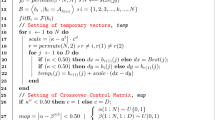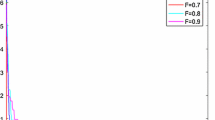Abstract
Recently, many studies have focused on differential evolution (DE), which is arguably one of the most powerful stochastic real-parameter optimization algorithms. Prominent variants of this approach largely optimize the DE algorithm; however, almost all the DE algorithms still suffer from problems like difficult parameter setting, slow convergence rate, and premature convergence. This paper presents a novel adaptive DE algorithm by constructing a trial vector generation pool, and dynamically setting control parameters according to current fitness information. The proposed algorithm adopts a distributed topology, which means the whole population is divided into three subgroups with different mutation and crossover operations used for each subgroup. However, a uniform selection strategy is employed. To improve convergence speed, a directional strategy is introduced based on the greedy strategy, which means that an individual with good performance can evolve rapidly in the optimal evolution direction. It is well known that the faster an algorithm converges, the greater the probability of premature convergence. Aimed at solving the local optimum problem, the proposed algorithm introduces a new mathematical tool in the selection process, called the membership cloud model. In essence, the cloud model improves the diversity of the population by randomly generating cloud droplets. Experimental results from executing typical benchmark functions show high quality performance of the proposed algorithm in terms of convergence, stability, and precision. They also indicate that this improved differential evolutionary algorithm can overcome the shortcoming of conventional differential evolutionary algorithms of low efficiency, while effectively avoiding falling into a local optimum.





Similar content being viewed by others
References
Brest J, Mauec MS (2008) Population size reduction for the differential evolution algorithm. Appl Intell 29(3):228–247
Brest J, Greiner S, Boskovic B, Mernik M, Zumer V (2006) Self-adapting control parameters in differential evolution: a comparative study on numerical benchmark problems. IEEE Trans Evol Comput 10(6):646–657
Cai YQ, Wang JH (2013) Differential evolutionwith neighborhood and direction information for numerical optimization. IEEE Trans on Cybernetics 43(6):2202–2215
Das S, Suganthan PN (2011) Differential evolution: A survey of the state-of-the-art. Evol Comput 15(1):4–31
Das S, Abraham A, Chakraborty UK, Konar A (2009) Differential evolution using a neighborhood based mutation operator. IEEE Trans Evol Comput 13(3):526–553
Ding JL, Liu J, Chowdhury KR, Zhang WS, Hu QP, Lei J (2014) A particle swarm optimization using local stochastic search and enhancing diversity for continuous optimization. Neurocomputing 137(0):261–267
Dorronsoro B, Bouvry P (2011) Improving classical and decentralized differential evolution with new mutation operator and population topologies. IEEE Trans Evol Comput 15(1):67– 98
Eiben AE, Hinterding R, Michalewicz Z (1999) Parameter control in evolutionary algorithms. IEEE Trans Evol Comput 3(2):124–141
Gao XZ, Wang XL, Ovaska SJ (2009) Fusion of clonal selection algorithm and differential evolution method in training cascade-correlation neural network. Neurocomputing 72(10–12):2483–2490
Gao Y (2009) An optimization algorithm based on cloud model. In: 2009 International Conference on Computational Intelligence and Security, pp 84–87
Li DY, Du Y (2005) Artificial Intelligence with Uncertainty (in Chinese). National Defense Industry Press, Beijing
Li D Y, Liu C Y (2005) Study on the universality of the normal cloud model. Eng Sci 3(2):18–24
Li DY, Meng HJ, Shi XM (1995) Membership clouds and membership cloud generators (in chinese). Journal of Computer Research and Development 32(6):15–20
Li DY, Liu CY, Gan WY (2009) A new cognitive model: Cloud model. Int J Intell Syst 24(3):357–375
Liang JJ, Qu BY, Suganthan PN, Hernández-Díaz AG (2013) Problem definitions and evaluation criteria for the cec 2013 special session on real-parameter optimization. Tech. rep., Computational Intelligence Laboratory, Zhengzhou University, Zhengzhou China
Liu G, Li YX, Nie X, Zheng H (2012) A novel clustering-based differential evolution with 2 multi-parent crossovers for global optimization. Appl Soft Comput 12(2):663–681
Mallipeddi R, Suganthan PN, Pan QK, Tasgetiren MF (2011) Differential evolution algorithm with ensemble of parameters and mutation strategies. Appl Soft Comput 11(2):1679–1696
Omran MGH, Salman A, Engelbrecht AP (2005) Self-adaptive differential evolution. Springer, Berlin Heidelberg, pp 192–199. chap International Conference, CIS 2005, Xian, China, December 15–19, 2005, Proceedings Part I
Pan QK, Suganthan PN, Ling W, Liang G, Mallipeddi R (2011) A differential evolution algorithm with self-adapting strategy and control parameters. Comput Oper Res 38(1):394–408
Price KV (1999) An introduction to differential evolution. In: Corne D, Dorigo M, Glover F (eds) New ideas in optimization. McGraw-Hill, Ltd., UK, pp 79–108
Qin AK, Huang VL, Suganthan PN (2009) Differential evolution algorithm with strategy adaptation for global numerical optimization. IEEE Trans Evol Comput 13(2):398– 417
Storn R, Price K (1997) Differential evolution - a simple and efficient adaptive scheme for global optimization over continuous spaces. J Glob Optim 11(4):341–359
Suganthan PN, Hansen N, Liang JJ, Deb K, Chen YP, Auger A, Tiwari S (2005) Problem definitions and evaluation criteria for the cec 2005 special session on real-parameter optimization. Nanyang Technological University, Tech. rep.
Tanabe R, Fukunaga A (2013) Success-history based parameter adaptation for differential evolution. In: Evolutionary Computation (CEC), 2013 IEEE Congress on, pp 71–78
Vafashoar R, Meybodi MR, Azandaryani AHM (2012) Cla-de: a hybrid model based on cellular learning automata for numerical optimization. Appl Intell 36(3):735–748
Varadarajan M, Swarup KS (2008) Differential evolutionary algorithm for optimal reactive power dispatch. Electrical Power and Energy Systems 30(8):435–441
Wang X, Zhao SG (2013) Differential evolution algorithm with self-adaptive population resizing mechanism. Math Probl Eng 2013(2013):1–14
Wang Y, Cai Z, Zhang Q (2011) Differential evolution with composite trial vector generation strategies and control parameters. IEEE Trans Evol Comput 15(1):55–66
Wilcoxon F (1945) Individual comparisons by ranking methods. Biometrics Bulletin 1(6):80–83
Yao X, Liu Y, Lin G (1999) Evolutionary programming made faster. IEEE Trans Evol Comput 3(2):82–102
Yildiz AR (2013) Hybrid taguchi-differential evolution algorithm for optimization of multi-pass turning operations. Appl Soft Comput 13(3):1433–1439
Zaharie D (2003) Control of population diversity and adaptation in differential evolution algorithms. In: Matousek R, Osmera P (eds) In: 2003 9th international conference on soft computing, pp 41–46
Zhan ZH, Zhang J, Li Y, Shi YH (2011) Orthogonal learning particle swarm optimization. IEEE Trans Evol Comput 15(6):832–847
Zhang JQ, Sanderson AC (2009) Jade: adaptive differential evolution with optional external archive. IEEE Trans Evol Comput 13(5):945–958
Zhang JZ, Ding XM (2011) A multi-swarm self-adaptive and cooperative particle swarm optimization. Eng Appl Artif Intell 24(6):958–967
Zhao SZ, Suganthan PN, Das S (2011) Self-adaptive differential evolution with multi-trajectory search for large-scale optimization. Soft Comput 15(11):2175–2185
Zhao ZQ, Gou J, Wang J (2010) Directional evolutionary algorithm based on fitness gradient of individuals (in chinese). Pattern Recognit Artif Intell 23(1):29–37
Zheng YJ, Ling HF, Xue JY (2014) Ecogeography-based optimization: Enhancing biogeography-based optimization with ecogeographic barriers and differentiations. Comput Oper Res 50(0):115–127
Zhu CM, Ni J (2012). Cloud model-based differential evolution algorithm for optimization problems. In: 2012 Sixth International Conference on Internet Computing for Science and Engineering, pp 55–59
Acknowledgements
This work was supported by the National Natural Science Foundation of China (No. 61103170, 51305142, 61305085), the Program for Prominent Young Talent in Fujian Province University (No. JA12005), the Program for Prominent Young Talent in Fujian Province University (No. JA12005), and the Promotion Program for Young andMiddle-aged Teachers in Science and Technology Research at Huaqiao University (No. ZQN-PY211).
Author information
Authors and Affiliations
Corresponding author
Rights and permissions
About this article
Cite this article
Gou, J., Guo, WP., Hou, F. et al. Adaptive differential evolution with directional strategy and cloud model. Appl Intell 42, 369–388 (2015). https://doi.org/10.1007/s10489-014-0592-3
Published:
Issue Date:
DOI: https://doi.org/10.1007/s10489-014-0592-3




